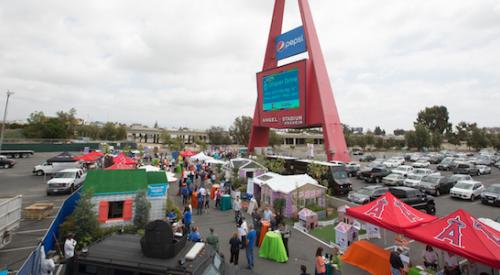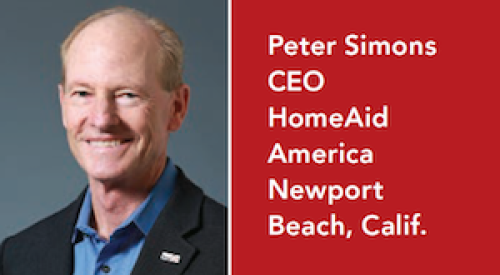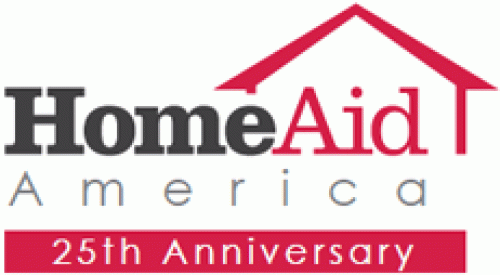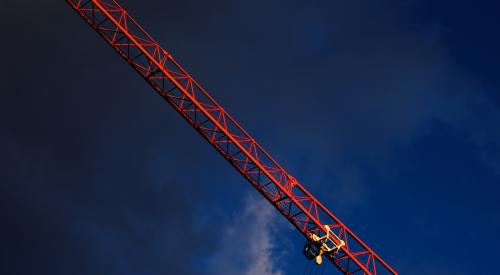|
They have a big story to tell, and they tell it without benefit of a celebrity spokesperson, a big media presence or the lavish fund-raising events that enhance awareness of many charitable organizations. They are HomeAid America, and with a nine-member staff, plus more than 30,000 dedicated volunteers in the home building industry, they are making a difference in the lives of temporarily homeless men, women and children across the country.
“Word of mouth, the generosity of our industry and measurable results have made the model a success,” says Mike Lennon, CEO of HomeAid America. “The home building community is very civic-minded, and the success of HomeAid is a wonderful testimonial to this dynamic.”
The goals are at once humble and ambitious: to provide shelter for and restore hope to the temporarily homeless in America. A person who lacks a fixed, regular and adequate nighttime residence is considered homeless. The temporarily homeless have an immediate need for food, clothing and shelter, usually because of the fallout from sudden job loss, catastrophic illness or spousal desertion.
| Providing Shelter: HomeAid America, Mike Lennon |
People who find themselves homeless have many faces and many stories. The bottom line is that the population of homeless is dishearteningly large. On any given night, as many as 1 million Americans are without safe, adequate shelter. The working poor account for a large percentage of them.
Reversing the trend is the HomeAid mission. In addition to bringing hope and homes to thousands of transitionally homeless, HomeAid’s efforts have helped local NAHB chapters generate positive recognition for the home building industry. HomeAid helps the public see that builders care about the communities where they build. Formerly with the Building Industry Association as a public affairs expert, Lennon says that creating awareness is a key component of the HomeAid agenda. “Our volunteers and sponsors include skilled professionals dedicated to changing lives,” he says. “They continually illustrate that the HomeAid program is one of the best examples of building industry community involvement.”
Originally established as HomeAid Orange County, HomeAid America began as a charitable nonprofit organization in June 1989 as part of the BIA of Southern California. The idea was to meet the needs of the homeless through what Lennon calls a “natural partnership” of agencies and builders. “Nonprofit homeless-care providers know their clientele and the physical and programmatic needs for the shelters they seek,” he explains. “The HomeAid team knows how to build and renovate shelters. We’ve established a partnership that really works.”
Today, HomeAid is the nation’s largest provider of shelter beds for the temporarily homeless. The overwhelming success of its Orange County startup inspired the push to go nationwide, which began in 1995 and continues steadily. Today, 15 chapters serve California, Colorado, Georgia, Illinois, Texas, Virginia and Washington. Plans for 2002 include new chapters in the District of Columbia, Florida, Michigan, Minnesota, Nevada, New York and North Carolina. HomeAid America hopes to have 58 chapters in major metropolitan areas across the United States during the next five years.
Expansion is linked to carefully tailored logistics, says Lennon. “We are making HomeAid a turnkey program as chapters open, with solid background information for potential chapters and a clear understanding of what is needed in terms of agency partners. We do studies for homelessness in each region or area that is contemplating a chapter, and we look for partnerships with builders who have NAHB affiliations. We also do outreach. If we’re aware of particular issues in certain places, we’ll start the ball rolling, but most often we are approached first.”
Multifaceted, potent support from HomeAid’s sponsors has generated funding to assist expansion efforts and spread the word. Founding sponsors include First American Title Insurance, the National Housing Endowment and the Wells Fargo Housing Foundation. National builder sponsors include Beazer Homes, Lennar Homes, Pardee Homes, Shea Homes and Standard Pacific Homes. All have participated as builder captains, a linchpin of HomeAid’s effectiveness. All have brought new contributors on board.
Builder captains are selected for a shelter project, working with the service agency to execute the design and construction plan. They marshal the donated material, labor and expertise of countless industry personnel who have given thousands of hours to the cause. Working under builder captain supervision, these largely unsung heroes include industry subcontractors, suppliers and consultants.
HomeAid America’s cash and in-kind contributions boost the value of the shelter projects, enabling partnering agencies to obtain much more for their dollars. “The ratio of built value to cash spent is about 3-to-1,” Lennon says. “For $300,000 to $350,000, we’re able to realize a property valued at about $1 million. This means a better facility than many agencies could manage without this leverage.”
Because emergency shelter is not HomeAid’s objective, a secure, clean place to sleep is only part of the equation. Partnership is with agencies focused on self-sufficiency. Whether such an agency is helping a pregnant teenager, an abused spouse or a mentally disabled adult, life skills are critical for moving the client out of the shelter and into the mainstream. Writing a check, budgeting, high school equivalency, job training and child care are among the basics of many HomeAid/agency partnerships.
Some HomeAid milestones are easy to recount, and impressive. Since inception, HomeAid has:
- provided some 2,000 beds.
- assisted some 20,000 people, including abused children, women in crisis pregnancy, the mentally disabled, adults living with HIV/AIDS, homeless youth ages 11-17, single mothers and their children, and victims of domestic violence.
- completed 66 shelter projects, with 20 more under way.
- raised more than $35 million in cash and in-kind contributions through the efforts of more than 5,000 companies and 30,000 individuals.
- expanded from a local entity to a national presence in little more than a decade, with a public/private dynamic the Department of Housing and Urban Development hails as one of the best of its kind in the United States.
With the process constantly refined, new challenges emerge, notably outcome measurement. “We are working on a formula that will provide more accurate evaluation and reporting from our chapters,” Lennon says. “Quantifying success is important. Qualifying is just as vital because it will help us see where we’ve been, where we’re going and what we need to do to further our mission.”
Awareness is still hampered by myth, Lennon says. “Homelessness is a circumstance, not an identity. But we’ve all heard the myths: The poor want to be poor. They are lazy. They are losers. In fact, the lack of affordable housing combined with such issues as job loss, low wages and domestic violence are the underpinnings of pervasive homelessness.”
One shelter at a time, HomeAid counteracts the myths with positive new starts for shelter residents. “With a proven track record, it’s ready to implement anywhere there’s a need,” says Bob Mitchell, past president of the NAHB. “With the HomeAid program, we’re building more than a shelter, we’re building new lives across America.”
Participants in HomeAid projects benefit nearly as much as the end users, Lennon says. “There is no other program in America that is addressing transitional housing on a national basis. Our teams are devoted and rightly proud of their contribution to this effort.”
To learn more about the HomeAid program, log on to www.homeaid.org or call 714/662-6822.










